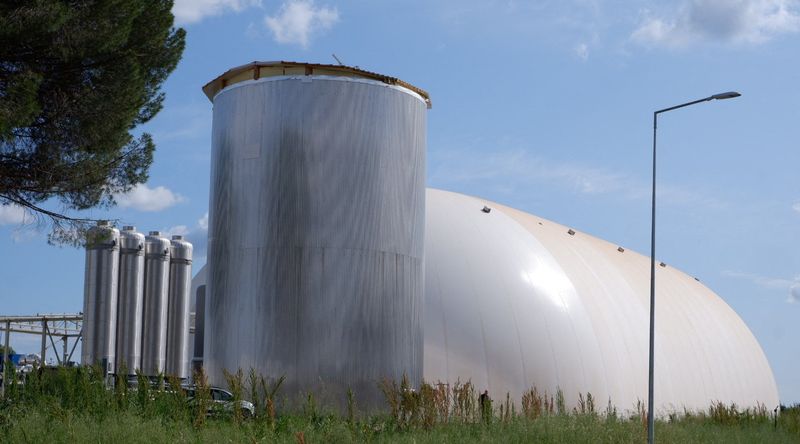By Federico Maccioni
OTTANA, Italy (Reuters) - Oman's sovereign wealth fund and Dutch multinational Vopak are among new investors betting on Italian renewable energy storage firm Energy Dome, whose technology does not rely on strategic raw materials.
As the European Union races to meet ambitious green goals, industry analysts say Energy Dome's technology could be one way to increase storage of intermittent wind and solar electricity so it is available when required.
The Milan-based company's storage system is based on turning carbon dioxide (CO2) gas into a liquid and vice versa, which it says is cost-effective.
The method has no need for minerals, including lithium and copper, that are currently central to much clean technology. This is particularly compelling when Brussels is concerned about China's dominance of the mineral supply chain.
Energy Dome announced on Thursday it had raised 15 million euros under the second tranche of its Series B funding round, bringing total funds so far to around 70 million euros ($78.65 million).
"Our challenge is precisely to prove to the financial world that this technology translates into sustainable cash flows," founder and CEO Claudio Spadacini told Reuters.
Energy Dome, which lists Barclays (LON:BARC) and energy group Eni among its existing backers, said new investors included the growth stage technology investment arm of the Omani fund, Vopak Venture, and investors represented by impact investing advisory firm Sagana.
It also signed a memorandum of understanding with the Omani fund to explore areas of collaboration in the Gulf state, which announced in December it would allocate close to $5 billion for investment projects in 2023.
Spadacini said Energy Dome's commercial pipeline was worth "well over" 9 gigawatt/hour, and it was working with Italian utility A2A and several larger groups abroad, including two in the United States.
'WHITE BALLOON'
Encircled by sun-scorched grassland in the centre of the island of Sardinia, Energy Dome's pilot plant rises in the shape of an elliptical white balloon from parts of an old industrial hub near the town of Ottana.
Two plastic membranes - the outer one painted in white and akin to those used to cover indoor tennis courts - form the CO2-filled dome the company is named after.
The battery storage system works somewhat "like charging your mobile at home," its co-founder and Chief Product Officer Francesco Oppici said.
During a "charge phase", the plant draws electricity from the grid and uses it to power a compressor that helps to turn the CO2 stored in the dome into a liquid.
This generates heat that is used to make the liquid CO2 evaporate as a hot, high-pressure gas that powers a turbine for a generator. This injects the electricity back into the grid before the gas fills the dome again, in a closed cycle.
The company said that storing electric energy using its technology cut costs by 40% compared with lithium batteries.
By the end of 2024, Energy Dome aims to deliver its first full-scale plant in Sardinia, with a 24-hour cycle and a 20-megawatt capacity able to power 13,000-15,000 houses.
It will cover four-to-five hectares, about 7% of the area needed for a solar farm with a 20 MW capacity.
Analysts say lithium-free solutions are likely to have a growing role in the energy transition.

"At the moment these technologies appear to be small niches in the market ... but they may develop more quickly than we imagine," said Michele Governatori, head of the power and gas programme at Italian climate change think-tank ECCO.
($1 = 0.8901 euros)